Publications (CCARH): Difference between revisions
| (87 intermediate revisions by the same user not shown) | |||
| Line 1: | Line 1: | ||
==Beyond MIDI: The Handbook of Musical Codes== | ==Beyond MIDI: The Handbook of Musical Codes== | ||
[https://wiki.ccarh.org/wiki/Beyond_MIDI:_The_Handbook_of_Musical_Codes <i>Beyond MIDI</i>] | |||
==Computing in Musicology (series)== | ==Computing in Musicology (series)== | ||
| Line 5: | Line 7: | ||
The fifteen volumes in this series (1985-2008) can be divided into three groups: | The fifteen volumes in this series (1985-2008) can be divided into three groups: | ||
===<b>Volumes 1-5</b>=== | |||
Published under the title <i>Directly of Computer-Assisted Research in Music</i>, compiled and distributed by CCARH. | |||
[http://ichriss.ccarh.org/protected/ccarh-scan-archive/20-01_CM01/20-01_CM01.pdf <i>Directory of Computer-Assisted Research in Musicology</i> (Computing in Musicology 1, 1985)] | [http://ichriss.ccarh.org/protected/ccarh-scan-archive/20-01_CM01/20-01_CM01.pdf <i>Directory of Computer-Assisted Research in Musicology</i> (Computing in Musicology 1, 1985)] | ||
| Line 15: | Line 18: | ||
[http://ichriss.ccarh.org/protected/ccarh-scan-archive/20-05_CM05/20-05_CM05.pdf <i>Directory of Computer Assisted Research in Musicology</i> (Computing in Musicology 5, 1989)] | [http://ichriss.ccarh.org/protected/ccarh-scan-archive/20-05_CM05/20-05_CM05.pdf <i>Directory of Computer Assisted Research in Musicology</i> (Computing in Musicology 5, 1989)] | ||
{| class="wikitable" | |||
|- | |||
! Volume No. !! Cover !! Highlights | |||
|- | |||
| [http://ichriss.ccarh.org/protected/ccarh-scan-archive/20-01_CM01/20-01_CM01.pdf No. 1 (1985)] || [[file:CM01-2.png|160px|thumb|center]] || Input codes of the mainframe era: DARMS, Fastcode, IML, MusTran, SCORE/MS; Hardware input schemes; Databases and encoded editions of music. | |||
|- | |||
| [http://ichriss.ccarh.org/protected/ccarh-scan-archive/20-02_CM02/20-02-CM02.pdf No. 2 (1986)] || [[file:CM02-2.png|160px|thumb|center]] ||Rudiments of the future field of digital musicology: Standards discussions, dissertations, one-of-a-kind academic systems, analysis of encoded data. | |||
|- | |||
| [http://ichriss.ccarh.org/protected/ccarh-scan-archive/20-03_CM03/20-03_CM03.pdf No. 3 (1987)] || [[file:CM03-2.png|160px|thumb|center]] || Search for coherent directions: The Representation of Musical Information in Machine-Readable Form (Walter Hewlett); Inventory of Musical Characters (Stephen Dydo); Updated Survey of Music-Printing software (with graphical samples, Ed Correia). | |||
|- | |||
| [http://ichriss.ccarh.org/protected/ccarh-scan-archive/20-04_CM04/20-04_CM04.pdf No. 4 (1988)] || [[file:CM04-2.png|160px|thumb|center]] ||Pursuit of standards for music-encoding; optical music recognition; input methods of music-encoding, with graphical samples of set examples, including Beethoven's "Harp" quartet (Ed Correia). | |||
|- | |||
| [http://ichriss.ccarh.org/protected/ccarh-scan-archive/20-05_CM05/20-05_CM05.pdf No. 5 (1989)] || [[file:CM05-2.png|160px|thumb|center]] || Optical music recognition from set examples; survey of necessary music attributes (Dorothy Gross); Databases involving encoded music; Music-printing survey (46 contributors); Cumulative Indices, Vols 1-5 (Steven Rasmussen). | |||
|} | |||
===<b>Volumes 6-10</b>=== | |||
Published under the title <i>Computing in Musicology: A Directory of Research</i>, compiled and distributed by CCARH. | |||
[http://ichriss.ccarh.org/protected/ccarh-scan-archive/20-06_CM06/20-06_CM06.pdf <i>Computing in Musicology: A Directory of Research</i> (Computing in Musicology 6, 1990)] | [http://ichriss.ccarh.org/protected/ccarh-scan-archive/20-06_CM06/20-06_CM06.pdf <i>Computing in Musicology: A Directory of Research</i> (Computing in Musicology 6, 1990)] | ||
| Line 23: | Line 40: | ||
[http://ichriss.ccarh.org/protected/ccarh-scan-archive/20-07_CM07/20-07_CM07.pdf <i>Computing in Musicology: A Directory of Research</i> (Computing in Musicology 7, 1991)] | [http://ichriss.ccarh.org/protected/ccarh-scan-archive/20-07_CM07/20-07_CM07.pdf <i>Computing in Musicology: A Directory of Research</i> (Computing in Musicology 7, 1991)] | ||
= | [http://ichriss.ccarh.org/protected/ccarh-scan-archive/20-08_CM08/20-08_CM08.pdf <i>Computing in Musicology: A Directory of Research</i> (Computing in Musicology 8, 1992)] | ||
[http://ichriss.ccarh.org/protected/ccarh-scan-archive/20-09_CM09/20-09_CM09.pdf <i>Computing in Musicology: A Directory of Research</i> (Computing in Musicology 9, 1993-94)] | |||
[http://ichriss.ccarh.org/protected/ccarh-scan-archive/20-10_CM10/20-10_CM10.pdf <i>Computing in Musicology: A Directory of Research</i> (Computing in Musicology 10, 1995-96)] | |||
{| class="wikitable" | |||
|- | |||
! Volume No. !! Cover !! Highlights | |||
|- | |||
| [http://ichriss.ccarh.org/protected/ccarh-scan-archive/20-06_CM06/20-06_CM06.pdf No. 6 (1990)] || [[file:CM06-2.png|160px|thumb|center]] || | |||
*Encoding Neumes and Mensural Notation | |||
*Technical Standards--MIDI File Format, SMDL, TEI | |||
*Dance Notation Software | |||
*Software for Music Theory and Analysis | |||
*Dedicated Applications | |||
|- | |||
| [http://ichriss.ccarh.org/protected/ccarh-scan-archive/20-07_CM07/20-07_CM07.pdf No. 7 (1991)] || [[file:CM07-2.png|160px|thumb|center]] || | |||
* Resources (Beethoven Bibliography, IDEAMA [electronic music], <i>Thesaurus Musicarum Latinarum) | |||
* Repertory-specific Applications (Melodic Grammars, Villancico Texts, Encoding Lute Tablatures) | |||
* Software for Music Analysis (Humdrum Toolkit, LabanWriter, MacGAMUT) | |||
* Braille Music Transcription | |||
* Automatic recognition, arrangement, accompaniment | |||
|- | |||
| [http://ichriss.ccarh.org/protected/ccarh-scan-archive/20-08_CM08/20-07_CM08.pdf No. 8 (1992)] || [[file:CM08-2.png|160px|thumb|center]] || | |||
* Melodic Analysis (8 contributions) | |||
* Rhythmic Representation (3 contributions); Harmony and Counterpoint (4 contributions) | |||
* Sound Analysis and Control (8 contributions) | |||
* Style Simulation (2 contributions) | |||
* Cognition (2 contributions), Connectionism (5 contributions), Compositional Process (2 contributions) | |||
|- | |||
| [http://ichriss.ccarh.org/protected/ccarh-scan-archive/20-09_CM09/20-09_CM09.pdf No. 9 (1993-94)] || [[file:CM09-2.png|160px|thumb|center]] || | |||
*Thesaurus Musicarum Latinarum (Thomas Mathiesen) | |||
*CANTUS (Ruth Steiner) | |||
*Music Theory Online (Lee Rothfarb) | |||
*The MuseData Universe (Selfridge-Field) | |||
*Bach: The Font (Yo Tomita) | |||
*The EsAC Electronic Songbooks (Helmuth Schaffrath) | |||
*Optical Music Recognition (Selfridge-Field, William McGee, Nicholas Carter) | |||
*Music Notation Software (Edmund Correia and many contributors) | |||
|- | |||
| [http://ichriss.ccarh.org/protected/ccarh-scan-archive/20-10_CM10/20-10_CM10.pdf No. 10 (1995-96)] || [[file:CM10-2.png|160px|thumb|center]] || | |||
*Studies in computational music analysis (David Huron, William Forde Thompson, Steve Rasmussen, Kevin Moll et al.) | |||
*Italian Music Theory in Digitized Treatises (Frans Wiering) | |||
*Tools and Methods (Andreas Kornstädt, Walter Hewlett, Guerrino Mazzola, Doncha O Maidin, Emi Lubej et al.) | |||
*Systems Perspectives (James Rhodes) | |||
*Studies in Rhythm and Meter (J.-D. Humair, Ira Braus) | |||
*Special Topics in Notation (Werner Icking, Thomas Brodhead, William McCann, David Halperin) | |||
|} | |||
===<b>Volumes 11-15</b>=== | |||
Topical collections of articles published in alternate years under the title <i>Computing in Musicology</i> by CCARH and distributed by The MIT Press. | |||
{| class="wikitable" | |||
|- | |||
! Vol. No. !! Cover !! Highlights | |||
|- | |||
| [http://ichriss.ccarh.org/protected/ccarh-scan-archive/20-11_CM11/20-11_CM11.pdf No. 11 (1998-99)] || [[file:CM11-01.PNG|160px|center|thumb]] || | |||
<i>Melodic Similarity: Concepts, Procedures, and Applications</i> | |||
*<i>Concepts and Procedures</i>: Conceptual and Representational Issues (E. Selfridge-Field); Geometrical Algorithms (D. O'Maidin); String-matching Techniques (T. Crawford et al.); Sequence-based Melodic Comparison (L.A. Smith et al.) | |||
*<i>Tools and Applications</i>: RISM Sorting Strategies (J. Howard); Signatures and Earmarks (D. Cope); Neural Models for Chorale Harmonization (D. Hörnel); Melodic Pattern-Detection (N. Nettheim); Rhythmic Elements of Melodic Practice (M. Yako) | |||
*<i>Human Melodic Judgments</i>: Melodic Similarity in Copyright Infringement (C. Cronin); Human and Machine Authorship Judgments (E. Dahlig et al.) | |||
*<i>Online Tools for Melodic Search</i>: MELDEX (D. Bainbridge); Themefinder (A. Körnstädt) | |||
|- | |||
| [http://ichriss.ccarh.org/protected/ccarh-scan-archive/20-12_CM12/20-12_CM12.pdf No. 12 (2000-2001)] || [[file:CM12-01.PNG|160px|center|thumb]] || | |||
<i>The Virtual Score: Representation, Retrieval, and Restoration</i> | |||
*<i>Representation and Interchange</i>: C.M.M.E. (Th. Dumitrescu), Hildegard von Bingen (S. Morent), NIFF-to-Braille MN (D. Langolff et al.), Music Notation to Braille MN (Silas Brown), Score-level Representation with GUIDO (Holger Hoos et al.), an XML Introduction (G. Casten, M. Good, P. Roland), | |||
*<i>Retrieval and Analysis</i>: Geographical Localization of Musical Features (B. Aarden, D. Huron), Features of Monophonic Vocal Melodies (Jane Singer), A DARMS Parser for Hymn-tune Searching (J. Stanley, A. Kearns) | |||
*<i>Virtual Restoration of Sources</i>: Virtual Restoration in the DIAMM Project (A. Wathey, M. Bent, J. Craig McFeely); Image-Enhancement Procedures (Alejandro Planchart); Computer Collation of Divergent Early Print Instances (Ph. Brett, Jeremy Smith); Digital Imaging of Watermarks (D. Edge), An Electronic Facsimile of Berg's <i>Wozzeck</i> Sketches (P. Hall) | |||
|- | |||
| [http://ichriss.ccarh.org/protected/ccarh-scan-archive/20-13_CM13/20-13_CM13.pdf No. 13 (2002-03)] || [[file:CM13-01.PNG|160px|center|thumb]] || <i>Music Query: Methods, Models, and User Studies</i> | |||
*Automatic Synchronization of Musical Data (V. Arifi et al.) | |||
*Modeling Rhythmic Motif Structure (T. Weyde) | |||
*Melody as a Significant Musical Feature (W. Chai) | |||
*Automatic Motivic Rules (O. Lartillot et al.) | |||
*A Measure of Cognitive Distance (E. Selfridge-Field) | |||
*Transportation Distances (F. Wiering et al.) | |||
*Spontaneous User Behavior in "Vocal" Queries (M. Lesaffre et al.) | |||
|- | |||
| [http://ichriss.ccarh.org/protected/ccarh-scan-archive/20-14_CM14/20-14_CM14.pdf No. 14 (2004-05)] || [[file:CM14-01.PNG|160px|center|thumb]] || <i>Music Analysis East and West</i> | |||
*<i>European Musicology</i>: XML and Music XML (Michael Good et al.), <i>Aruspix</i> and <i>Wolfgang</i> (L. Pugin, Chr. Jeanneret), et al. | |||
*<i>Eurasian Musicology</i>: Byzantine Repertories (P. Mavromatis, A. Doneda) | |||
*<i>Asian Musicology</i>: Automatic Transcription of Tabla Music (P. Chordia); Melodic Atoms in Indian Classical Music (Arv. Krishnaswamy); Japanese Koto and its Melismatic Patterns (Cr. Sapp, S. Deguchi, K. Shirai),\; Microtonal Matchining in Indonesian Music (A. Uitdenbogerd, Imam S.H. Suyoto) | |||
|- | |||
| [http://xx No. 15 (2006-07)] || [[file:CM15-01.PNG|160px|center|thumb]] || <i>Tonal Theory for the Digital Age</i> | |||
*Cyclic-Distance Pattern in Diatonic Sets (O. Izmirli) | |||
*Tonal Properties of Pitch-class Sets (D. Temeperley) | |||
*Navigating Tonal Space (P. Janata) | |||
*Toroidal Models of Tonal Theory (H. Purwins et al.) | |||
*Automatic Chord Identification (S. Sapp) | |||
*Assessing Disputed Attributions (P. van Kranenburg) | |||
*Affinities between Metric and Tonal Structures (A. Volk et al.) | |||
*Chordal Evaluation in MIDI-based Harmonic Analysis (E. Ferkova et al.) | |||
*Visualization of Tonal Content in Visual and Audio Domains (P. Toiviainen) | |||
|} | |||
===<b>Editorial Credits</b>=== | |||
The series Computing in Musicology benefitted greatly from the contributions of in-house staff members Don Anthony, Edmund Correia, Steven Rasmussen, and Beth Youngdoff. The enthusiasm of the many notation-software developers who contributed their best work annually played an important role in moving the dial forward for all users. The musicologists and music theorists who sent in progress reports on individual work played an equally important role in helping to establish a field that was still in gestation. The contributing editors whose names are listed in each issue brought essential insights and perspectives. | |||
== | ==Reprints== | ||
Latest revision as of 01:15, 28 December 2021
Beyond MIDI: The Handbook of Musical Codes
Computing in Musicology (series)
The fifteen volumes in this series (1985-2008) can be divided into three groups:
Volumes 1-5
Published under the title Directly of Computer-Assisted Research in Music, compiled and distributed by CCARH. Directory of Computer-Assisted Research in Musicology (Computing in Musicology 1, 1985)
Directory of Computer-Assisted Research in Musicology (Computing in Musicology 2, 1986)
Directory of Computer Assisted Research in Musicology (Computing in Musicology 3, 1987)
Directory of Computer Assisted Research in Musicology (Computing in Musicology 4, 1988)
Directory of Computer Assisted Research in Musicology (Computing in Musicology 5, 1989)
| Volume No. | Cover | Highlights |
|---|---|---|
| No. 1 (1985) | 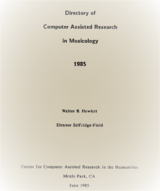 |
Input codes of the mainframe era: DARMS, Fastcode, IML, MusTran, SCORE/MS; Hardware input schemes; Databases and encoded editions of music. |
| No. 2 (1986) | 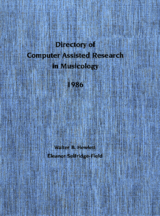 |
Rudiments of the future field of digital musicology: Standards discussions, dissertations, one-of-a-kind academic systems, analysis of encoded data. |
| No. 3 (1987) | 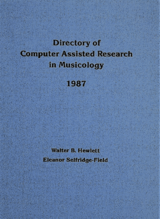 |
Search for coherent directions: The Representation of Musical Information in Machine-Readable Form (Walter Hewlett); Inventory of Musical Characters (Stephen Dydo); Updated Survey of Music-Printing software (with graphical samples, Ed Correia). |
| No. 4 (1988) | 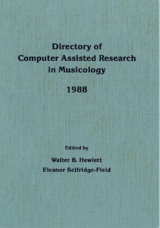 |
Pursuit of standards for music-encoding; optical music recognition; input methods of music-encoding, with graphical samples of set examples, including Beethoven's "Harp" quartet (Ed Correia). |
| No. 5 (1989) | 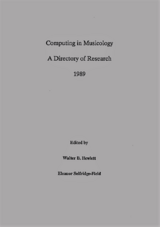 |
Optical music recognition from set examples; survey of necessary music attributes (Dorothy Gross); Databases involving encoded music; Music-printing survey (46 contributors); Cumulative Indices, Vols 1-5 (Steven Rasmussen). |
Volumes 6-10
Published under the title Computing in Musicology: A Directory of Research, compiled and distributed by CCARH.
Computing in Musicology: A Directory of Research (Computing in Musicology 6, 1990)
Computing in Musicology: A Directory of Research (Computing in Musicology 7, 1991)
Computing in Musicology: A Directory of Research (Computing in Musicology 8, 1992)
Computing in Musicology: A Directory of Research (Computing in Musicology 9, 1993-94)
Computing in Musicology: A Directory of Research (Computing in Musicology 10, 1995-96)
| Volume No. | Cover | Highlights |
|---|---|---|
| No. 6 (1990) | 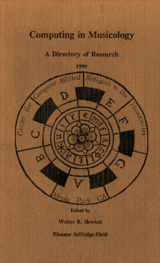 |
|
| No. 7 (1991) | 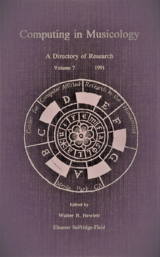 |
|
| No. 8 (1992) | 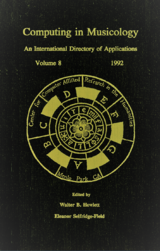 |
|
| No. 9 (1993-94) | 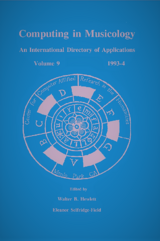 |
|
| No. 10 (1995-96) | 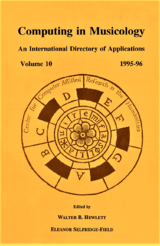 |
|
Volumes 11-15
Topical collections of articles published in alternate years under the title Computing in Musicology by CCARH and distributed by The MIT Press.
| Vol. No. | Cover | Highlights |
|---|---|---|
| No. 11 (1998-99) | 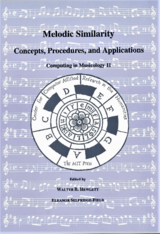 |
Melodic Similarity: Concepts, Procedures, and Applications
|
| No. 12 (2000-2001) | 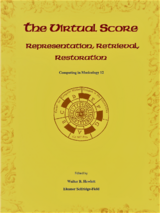 |
The Virtual Score: Representation, Retrieval, and Restoration
|
| No. 13 (2002-03) | 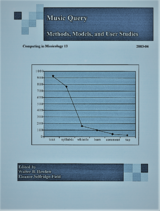 |
Music Query: Methods, Models, and User Studies
|
| No. 14 (2004-05) | 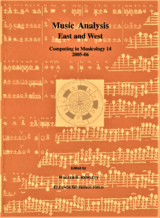 |
Music Analysis East and West
|
| No. 15 (2006-07) | 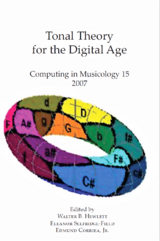 |
Tonal Theory for the Digital Age
|
Editorial Credits
The series Computing in Musicology benefitted greatly from the contributions of in-house staff members Don Anthony, Edmund Correia, Steven Rasmussen, and Beth Youngdoff. The enthusiasm of the many notation-software developers who contributed their best work annually played an important role in moving the dial forward for all users. The musicologists and music theorists who sent in progress reports on individual work played an equally important role in helping to establish a field that was still in gestation. The contributing editors whose names are listed in each issue brought essential insights and perspectives.